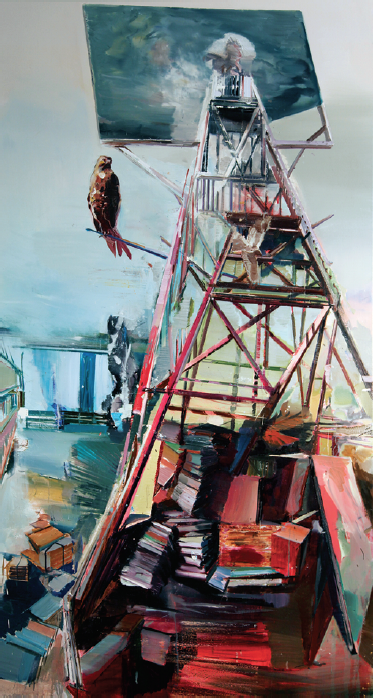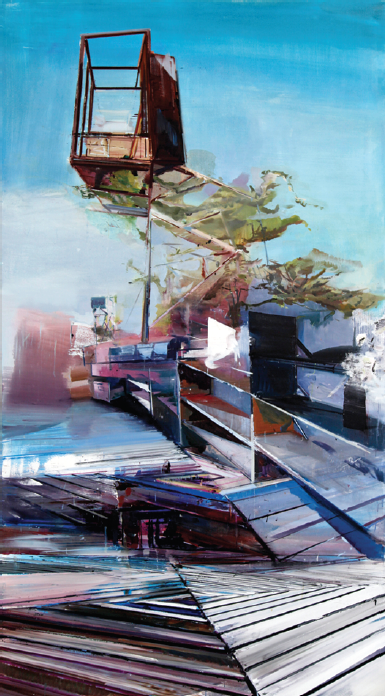Impossible Architectures
Martin Golland’s “The Archivist’s Etagere”
Martin Golland, the Ottawa-based painter and teacher, has been keeping himself busy. In his recent show at Toronto’s Birch Libralato, titled The Archivist’s Étagère, he exhibited three large tower paintings that showed an engagement with his present and with painting’s past. Through his interest in collage, he has catalogued both a physical and a digital archive of images and has employed them as a way of making paintings. Golland is a pragmatic entropist; when things wear down, they have to be remade. For him, painting has already been taken apart by “Modernism and what came after,” so his quest is to find new ways to reconstitute these residues of pictorial space. “I see myself as building from the fragments that exist throughout recent art history. I am trying to discover unexpected combinations and recombinations of reclaimed imagery.”

Martin Golland, What Not, 2012, oil on canvas, 108 x 60”. Images courtesy the artist and Birch Libralato, Toronto.
In What Not those parts add up to a whole. The painting is a fantastic build: it starts with a line of indigo trees that Constable could have planted, moves to a scaffolding that looks like the ruin of a Mark di Suvero sculpture, then to a column on the side of which hangs a geometric abstraction and on top, a fragment of a house, as if Gordon Matta-Clark had passed through the neighbourhood. The list sounds disconnected but the painting holds together like a seamless wall.

Scriptorium, 2012, oil on canvas, 108 x 60”.
Golland is enamoured of the shelf because it functions as a container and a vantage point. In Scriptorium a falcon sits near the top of another tower, underneath which is a tumult of scattered books. He sees the bird as a perceiving intelligence “that could survey the entire space and, in a way, suggest the space beyond the frame.” The bird of prey, a surrogate for the artist, is an answer to the painterly prayer.
The exhibition’s title painting collapses a boardwalk and a set of empty shelves in a work that reads simultaneously as real and painted space. “My work falls at different points along an axis of representation and abstraction. I wanted to make spaces that moved away from the more fragmented aspects in which I had been engaged, to build something more coherent. I don’t like it when a picture becomes too scattered and when the illusion of space is completely obliterated.”

Archivist’s Étagère, 2012, oil on canvas, 108 x 60”.
What these recent paintings indicate is that Golland is firmly in control of the flight pattern in this space. His view of figuration and abstraction is that they are not binary opposites, but conditions of mutual and continuous interaction. He describes this process as “the painterly factor–the brush strokes, the materiality of paint, its thickness and thinness, the canvas weave. It is the moment at which painting breaks down into the pictorial components that comprise the picture. That place occupies my interest.”
His new paintings build forms and spaces that embody this fluctuating process. “On the one hand, I’m trying to create something plausible, something that one can imagine existing in the world. But as you look closer, you realize that what you’re seeing is structurally unsound; it couldn’t exist outside of the space of painting.” Martin Golland is busy building. He is the painterly architect of the practically impossible. ❚
Order Issue 124 here.

